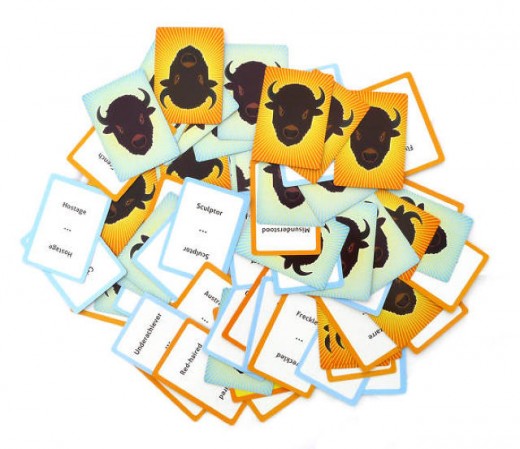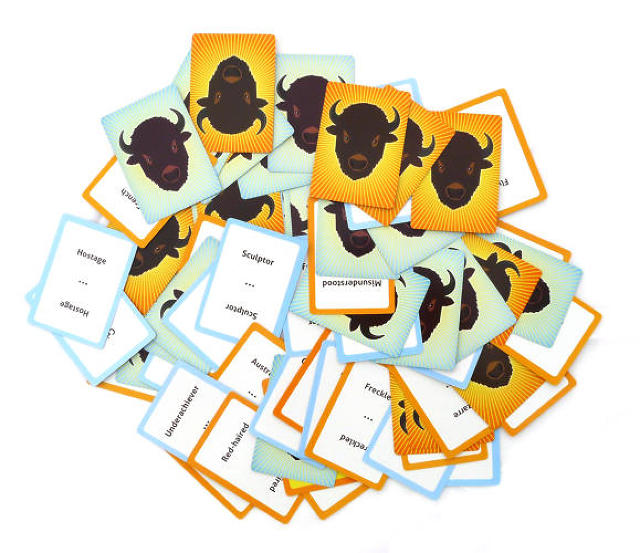A Simple Card Game Designed To Rewrite Gender And Racial Stereotypes
The neatest thing? It’s been proven to work.
You needn’t look any further than Gamergate to see how the crude depiction of women in video games, and various other media, has equated to rampant and deep-seeded sexism. And it’s enough to make you wonder, could the world really be better if games were designed in a way that didn’t reinforce culture’s worst stereotypes?
Now, a team of researchers from Dartmouth’s Tiltfactor Lab has proven that it can be. Its card game, Buffalo: The Name-Dropping Game, works a bit like War. Two people lay down cards at the same time. One card is an adjective (like “glasses-wearing,” or “Iranian”), and the other card is a noun (like “animal expert” or “soccer player”).

The goal? Come up with someone who fits that description. The experience feels like a fast-paced game of trivia, but under the surface, you’re being reprogrammed. By chance, you may have to come up with a combination like “multiracial superhero” or “female visionary.” And rather than unconsciously associating Christopher Reeve with superheroes or Steve Jobs with visionaries—as is so easy to do for people as lazy and white and male as myself!—you’re forced to consider alternatives like Miles Morales, the half-black, half-hispanic Spiderman, or Rosalind Franklin, the overlooked genius who was instrumental in discovering DNA.
And if you don’t know these names? That’s okay. In fact, that’s often the point.
“Uncertainty is key to the game’s success. It challenges the doubt of making assumptions of closed characteristics on gender, race, or religion,” says Geoff Kaufman, who is now Assistant Professor of the Human-Computer Interaction Institute at Carnegie Mellon. “It invites this level of skepticism of conclusions about people.”
“We’ve seen games that inspire agency beyond the game,” he continues, “[like] looking up answers they might look up for future game sessions.”

In one of many studies the team has run, 193 young adults played either Buffalo or a control game, and after that time, they were assessed on two standard psychological tests that measure tolerance and prejudice. And after just a single game, players of Buffalo were measurably more likely to be inclusive, and agree with statements like “There is potential for good and evil in all of us” or “I can see myself fitting into many groups.” And the thing is, researchers don’t believe their results need to be limited at all to Buffalo—but that games, across the board, could be designed through all sorts of methods to make all of us more tolerant.
“I think what’s interesting about games in this particular space is that games rely on agency. They don’t come to life unless there’s action by people. And that makes them different than film or other art form,” says Dr. Mary Flanagan, Professor in the Department of Film & Media Studies, and founding director of Tiltfactor Lab, at Dartmouth. “I look at World of Warcraft—with 11 million people in its heyday—what if the language and dialogue were involving this material? The game could have been a pro-social, anti-stereotyping, bias-prevention world. Wow, cool!”
There’s just one catch. While the team has performed multiple studies—including yet-unpublished feats like telling boys halfway through a game that they were really playing as princesses, and thus making them exhibit less gender bias—they have found that obfuscation, or hiding the game’s intent, can be vital, lest the results be nullified.
“No one wants to make a game where it’s not a game because you’re hitting people over the head with your message,” Flanagan says. “What’s important for people to take away is there are things you can bring into design practice: everyone can bring in attitudes to shift opinions through design choice.”
Fast Company , Read Full Story
(101)



